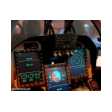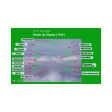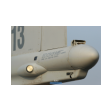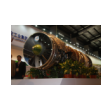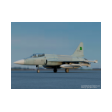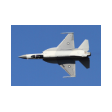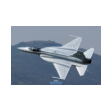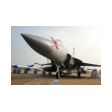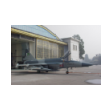CAC/PAC FC1-JF-17 Thunder
The PAC JF-17 Thunder is a light-weight, single-engine, multi-role combat aircraft developed jointly by the Pakistan Air Force, the Pakistan Aeronautical Complex (PAC) and the Chengdu Aircraft Industries Corporation (CAC) of China. Its designation "JF-17 Thunder" by Pakistan is short for "Joint Fighter-17", while the designation "FC-1 Xiaolong" by China means "Fighter China-1 Fierce Dragon".
The JF-17 can carry a variety of missiles and bombs, including air-to-air and air-to-surface missiles, supplemented by a 23/30 mm GSh-23-2 twin-barrel autocannon. It is powered by a RD-93 or WS-13 afterburning turbofan, and has a top speed of Mach 1.8. The JF-17 is slated to become the backbone of Pakistan Air Force (PAF), complementing the F-16s as well as the J-10Bs (on order) within its aircraft ranks and is also expected to fill the duties of aerial reconnaissance, ground-attack and interception.
Pakistan has already started induction, and has plans to induct around 250 units. The JF-17 will replace Pakistan's ageing fleet of A-5C, Mirage-III, Mirage-V, and F-7P/PG by 2015. The first squadron was inducted in the Pakistan Air Force in February 2010. In China it is in an evaluation phase (passed design appraisal).
Role: Multirole combat aircraft
National origin: China-Pakistan
Manufacturer: Chengdu Aircraft Industry Group-Pakistan Aeronautical Complex
First flight: 25 August 2003
Introduction: 12 March 2007
Status: In service, as of 18 February 2010
Primary user: Pakistan Air Force
Produced:
In China: June 2007–present
In Pakistan: January 2008–present
Number built: 100+(including 6 prototypes)
Program cost: US$500 million
Unit cost:
Block 1: US$15–20 million (estimated)
Block 2: US$20–25 million
Production, delivery and further development
Russia signed an agreement in August 2007 for re-export 150 RD-93 engines from China to Pakistan for the JF-17 fighter jet. Prior to the 2008 International Defence Exhibition and Seminar in Pakistan, news emerged that the PAF was not fully satisfied with the RD-93 turbofan engine and it would only power the first batch of 50 aircraft. It was reported that a deal for a new engine, believed to be the Snecma M53-P2, could appear during the exhibition.
On 2 March 2007, the first consignment of two small-batch-production (SBP) aircraft was received in Pakistan, arriving in dismantled form. They were then flown in Pakistan for the first time eights days later on 10 March 2007 and took part in an aerial demonstration to the public during Pakistan Day parade on 23 March 2007. It was intended that the PAF would induct 200 JF-17 by 2015 to replace all Chengdu F-7, Nanchang A-5, Dassault Mirage III/5 combat aircraft. It was also stated that the PAF was preparing for in-flight refuelling of JF-17 fighters ahead of their induction by upgrading a number of Mirage III fighters with IFR probes. A dual-seat combat-capable trainer was originally scheduled to begin flight testing in 2006; however, this model has apparently been cancelled, in 2009 it was reported that Pakistan had decided to develop the model intended for pilot training into a specialised attack variant.
In November 2007 the PAF and PAC conducted flight evaluation of the pre-production aircraft fitted with a variant of the NRIET KLJ-10 radar, designed and built by China's Nanjing Research Institute for Electronic Technology (NRIET), and the LETRI SD-10 active radar homing AAM. It was also stated by JF-17 program managers that they were seriously considering purchasing the Thales RC400 radar and MICA AAM from France for equipping the JF-17, meaning that in future the PAF could be operating a mixed fleet of JF-17 armed with Chinese and French radars and missiles.
PAC began manufacturing JF-17 sub-assemblies on 22 January 2008. Manufacture of parts had already begun at PAC in 2005. The PAF was to receive a further six pre-production aircraft that year, giving it a total of 8 out of an initial production run of 16 aircraft. Initial operating capability was to be achieved by the end of 2008. Final assembly of the JF-17 in Pakistan began on 30 June 2009, with PAC expected to complete production of 4–6 aircraft before the end of the year. PAC then plans to produce twelve aircraft in 2010 and 15–16 aircraft per year from 2011. This may eventually be increased to 25 aircraft per year.
Beyond the initial 50 PAF JF-17s, the remaining production aircraft may feature European avionics, radars and weaponry. Pakistan has been negotiating with British and Italian defence firms regarding avionics and radars for the JF-17 during development. Some of the radar options include the Italian Galileo Avionica Grifo S7, and the French Thomson-CSF RC400 (a variant of the RDY-2), along with the MBDA MICA IR/RF short–medium range AAMs. The Vixen 500E Active Electronically Scanned Array (AESA) radar has been offered to the PAF by the British company SELEX Galileo, but the PAF may be looking for a more advanced AESA radar for the JF-17.
In early 2010 it was reported that ATE Aerospace Group had been selected by the PAF to integrate various French avionics and weapons systems which would be supplied by other partners including Thales, Sagem and MBDA. Rival bids from Astrac, Finmeccanica and a Thales-Sagem joint venture were beaten by the ATE bid to upgrade 50 JF-17, with 50 more optional, at a cost of up to 1.36 billion dollars. The upgraded aircraft would go into production in 2013. The Thales RC-400 radar and MICA AAMs, as well as various air-to-surface weaponry, are believed to be included in the contract. The PAF is also in contact with South Africa for the supply of Denel A-darter AAMs.
In April 2010, the deal was reportedly suspended after 18 months of negotiations. Reports cited French concerns in regards to Pakistan's financial situation, the protection of sensitive French technology and lobbying by the Indian government, who operate large numbers of French-origin fighters. France wanted the PAF to purchase a number of French-built Mirage 2000-9 fighters from the United Arab Emirates Air Force, a sale which would be made unnecessary if the JF-17 upgraded with French systems. However in July 2010 these reports were stated to be false by the PAF's Chief of Air Staff, Air Chief Marshal Rao Qamar Suleman, "I have had discussions with French Government officials who have assured me that this is not the position of their government." Suleman also speculated that: "someone was trying to cause mischief – to put pressure on France not to supply the avionics we want."
As of 2010, with the FC-1 in direct competition with the MiG-29 in the international market, Russian aircraft manufacturers have raised concerns regarding the re-export of the FC-1's RD-93 engines. The FC-1 is competing against the MiG-29 in an Egyptian tender for 32 fighter aircraft. Mikhail Pogosyan, head of the MiG and Sukhoi design bureaus, has recommended to the Russian defence export agency Rosoboronexport that sales of RD-93 engines to China be blocked to prevent the JF-17 from competing with the MiG-29 on the international market. On 19 July 2010, according to a CATIC official at the Farnborough Airshow, China and Russia had already signed a contract for the delivery of 100 RD-93 engines and also an agreement for the latter supply of 500 engines. The official stated that China has received "nothing through official channels" and he believes "the engine is still an option for exported aircraft." At the same show, the JF-17 was displayed internationally for the first time. It was initially reported that JF-17s would perform aerial displays at the show but it was cancelled due to the late decision to go to Farnborough and the cost of license and insurance fees.
It has been reported that China and Pakistan are jointly working on a 4.5th generation version Block 2 JF-17 with an AESA radar and reduced RCS. In February 2012, it was announced that a two-seat version of the JF-17 Thunder fighter is being developed. The two-seater will be adaptable for conversion training and combat roles. In May 2011, China offered 50 JF-17s to Pakistan on an urgent basis at no cost.
![]() Argentina
Argentina
by Richard D Fisher Jr, Paris - IHS Jane's Defence Industry
Officials from Argentine aerospace company Fabrica Argentina de Aviones (FAdeA) told IHS Jane's at the 2013 Paris Air Show they have had multiple discussions with Chinese officials over potential co-production of the Chengdu Aircraft Corporation (CAC) FC-1/JF-17 multirole combat aircraft.
Discussions are far from concluded, with FAdeA officials saying "technology transfer" issues remain a sticking point. Nonetheless, the discussions are the first formal effort that could lead to the co-production of a modernChinese fighter in Latin America. FAdeA officials said the co-produced FC-1 could be called the 'Pulqui-III' ("Arrow" in Araucanian language), recalling FAdeA's Pulqui-II, Latin America's first swept wing jet fighter, which was designed by Germany's Kurt Tank for the government of Juan Peron.
Airframe and cockpit
The airframe is of semi-monocoque structure, constructed primarily of aluminium alloys. High strength steel and titanium alloys are partially adopted in some critical areas. The airframe is designed for a service life of 4,000 flight hours, or 25 years, the first overhaul being due at 1,200 flight hours. Block 2 JF-17s incorporate greater use of composite materials in the airframe to reduce weight.
The mid-mounted wings are of cropped-delta planform. Near the wing root are the LERX, which generate a vortex that has the effect of providing more lift to the wing at high angles of attack encountered during combat manoeuvres. A conventional tri-plane empennage arrangement is incorporated, with all-moving stabilators, single vertical stabiliser and rudder, as well as twin ventral fins. The flight control surfaces are operated by a computerised flight control system (FCS), which also adjusts the slats/flaps for improved manoeuvring. Up to 3,629 kg (8,000 lb) of ordnance, equipment and fuel can be mounted under the hardpoints, two of which are on the wing-tips, four under the wings and one under the fuselage.
The retractable undercarriage is of tricycle arrangement, with a single steerable nose-wheel and two main undercarriage. The hydraulic brakes have an automatic anti-skid system. The nosewheel retracts rearwards into the fuselage and the main gear wheels retract upwards into the engine intake trunks. Two bifurcated air inlets, one on either side of the fuselage behind and below the cockpit, provide the engine's air supply. The position and shape of the inlets is designed to give the required airflow to the jet engine during manoeuvres involving high angles of attack. A DSI design is used to simultaneously prevent boundary layer airflow entering the inlet and decelerate supersonic airflow.
The cockpit is covered by a transparent acrylic canopy designed to give the pilot a good all-round field of view. A centre stick is used for pitch and roll control while rudder pedals control yaw. A throttle is located to the left of the pilot. The cockpit incorporates hands-on-throttle-and-stick (HOTAS) controls. The pilot sits on a zero-zero ejection seat; either the Martin-Baker Mk-16LE, which will be used on Pakistan Air Force fighters, or the Chinese TY-5B also fitted to the Chengdu J-10.
Avionics
Aircraft
The software written for the JF-17's avionics totals more than one million lines of instructions, incorporating the concept of open architecture. Rather than using the Ada programming language, which is optimised for military applications, the software is written using the popular civilian C++ programming language to better use the large number of civilian software programmers available.The redesigned PT-04 prototype JF-17 had more advanced avionics than its predecessors, which are included on the production version of the aircraft.
The aircraft's glass cockpit incorporates an electronic flight instrument system (EFIS) and a wide-angle holographic head-up display (HUD), which has a minimum total field of view of 25 degrees. The EFIS is made up of three colour multi-function displays (MFD) providing basic flight information, tactical information and information on the engine, fuel, electrical, hydraulics, flight control and environment control systems. The HUD and MFD can be configured by the pilot to show any of the available information. Each MFD is 20.3 cm (8 in) wide and 30.5 cm (12 in) tall, arranged side-by-side in a portrait orientation. The central MFD is placed lower down to accommodate an up-front control panel between it and the HUD. The aircraft also includes a health and usage monitoring system and automatic test equipment.
The aircraft has a composite FCS consisting of conventional controls with stability augmentation in the yaw and roll axis and a digital fly-by-wire (FBW) system in the pitch axis. The leading edge slats/flaps and trailing edge flaps are adjusted by the FCS automatically during manoeuvring to increase turning performance. Some sources state that the system has been upgraded to provide fly-by-wire flight control in the roll and yaw axis also, the serial production aircraft having a digital quadruplex (quad-redundant) FBW system in the pitch axis and duplex (dual-redundant) FBW system in the roll and yaw axis.
Tactical
The communication systems comprise two VHF/UHF radios, one of them having capacity for data linking. The data link can be used to exchange data with ground control centres, airborne early warning and control aircraft and other combat aircraft also equipped with compatible data links. The ability to data link with other "nodes" such as aircraft and ground stations allows JF-17 to become part of a network, improving the situational awareness of the pilot and other entities in the network.
The JF-17 has a defensive aids system (DAS) made up of various integrated sub-systems. A radar warning receiver (RWR) gives data such as direction and proximity of enemy radars to the pilot and electronic warfare (EW) suite, housed in a fairing at the tip of the tail fin for greater coverage, that interferes with enemy radars. The EW suite is also linked to a Missile Approach Warning (MAW) system to help it defend against radar-guided missiles. The MAW system uses several optical sensors mounted on the airframe (two of which can be seen at the base of the vertical stabiliser) that detect the rocket motors of missiles and gives 360 degree coverage. Data collected by the MAW system, such as direction of inbound missiles and the time to impact, is also shown on the cockpit displays and HUD to warn the pilot. A counter-measures dispensing system releases decoy flares and chaff to help the aircraft evade enemy radars and missiles. The DAS systems will also be enhanced by integration of a self-protection radar jamming pod which will be carried externally on one of the aircraft's hardpoints.
The first 42 production aircraft currently being delivered to the PAF are equipped with the NRIET KLJ-7 radar,a smaller variant of the KLJ-10 radar fitted to the Chengdu J-10, developed by China's Nanjing Research Institute of Electronic Technology (NRIET). Its multiple modes allow surveillance and simultaneous engagement of multiple air, ground and sea targets, of which a total of 40 can be managed. Using the track-while-scan mode, the radar can track up to ten targets at BVR and engage two of them simultaneously with radar-homing AAMs. The operation range for targets with a radar cross-section (RCS) of 5 square metres (54 sq ft) is stated to be ≥105 km in look-up mode and ≥85 km in look-down mode.
It is known that a helmet-mounted sights/display (HMS/D) system will be installed on the JF-17, although the exact type is yet to be confirmed. A Chinese HMD is stated to be available for installation on the fighter. Developed by Luoyang Electro-Optics Technology Development Centre (also known as the 613th Research Institute when first started in 1970), of AVIC, it tracks the movement of the pilot's head and eyes to cue the guidance systems of missiles towards whichever target the pilot is looking at. According to the Chinese claim, this domestic Chinese HMS has a superior performance over the HMS on Su-27 Flanker series, and was developed in parallel with JF-17, with the prototype first begun to be tested on # 04 prototype of JF-17 in 2006,. However, it was not until two years later at the 7th Zhuhai Airshow held in 2008 when the developer confirmed the existence of the HMS. Dubbed as EO HMS, (Electro-Optical Helmet Mounted Sight), the new helmet with the mounting base was shown to the public at the airshow, but the sight itself was not present, only mentioned in the developer's brochure. Also to be integrated is a forward looking infrared (FLIR) pod for low-level navigation in low visibility and infra-red search and track (IRST) system for passive monitoring and targeting of enemy aircraft. The JF-17 Block 2 is believed to incorporate an IRST.
A day/night laser designator targeting pod will be integrated with the aircraft's avionics and carried externally on one of the hardpoints for guiding laser-guided bombs (LGB). An extra hardpoint may be added under the starboard air intake, opposite the cannon, for mounting such pods. No specific targeting pod has been selected, but a Chinese system such as the Forward-looking Infra-red Laser Attack Targeting (FILAT) pod may be integrated if a suitable Western system is not available. To reduce costs associated with buying large numbers of targeting pods, during strike missions the aircraft's tactical data link will be used to transmit targeting data to other aircraft not equipped with targeting pods.
Propulsion and fuel system
The JF-17 is powered by a single Russian RD-93 turbofan engine, which is a variant of the RD-33 engine used on the Mig-29 fighter. The engine gives more thrust and significantly lower specific fuel consumption than the turbojet engines fitted to older combat aircraft being replaced by the JF-17. The advantages of using only one engine are that both maintenance time and cost are significantly lower than twin-engined fighters. A thrust-to-weight ratio of 0.99 can be achieved, with full internal fuel tanks and no external payload. The engine's air supply is provided by two bifurcated air inlets (see airframe section). However the RD-93 is known to produce smoke trails.
The Guizhou Aero Engine Group has been developing a new turbofan engine, the WS-13 Taishan, since 2000 to replace the RD-93. It is based on the Klimov RD-33 but incorporates many new technologies to boost performance and reliability. Thrust output of 80–86.36 kN (19,391 lb), life span of 2,200 hours and thrust to weight ratio of 7.8 are expected. An improved version of the WS-13 developing a thrust of around 100 kN (22,450 lb) is also reportedly under development.
The fuel system comprises internal fuel tanks located in the wings and fuselage, with capacity for 2330 kg (5,130 lb) of fuel, that are refuelled through a single point pressure refuelling system (see turbine fuel systems). Internal fuel storage can be supplemented by external fuel tanks. One 800 litre droptank can be mounted on the aircraft's centerline hardpoint under the fuselage and two 800 litre or 1100 litre droptanks can be mounted on the two inboard under-wing hardpoints. The fuel system is also compatible with in-flight refuelling (IFR), allowing the aircraft to take on fuel from a tanker aircraft when an IFR probe is installed and increasing its range and loitering time significantly. All production aircraft for the Pakistan Air Force are to be fitted with IFR probes.
In June 2013, Pakistan Air Force chief Air Chief Marshall Tahir Rafique Butt said that the PAF had successfully completed ground tests on mid-air refuelling probes fitted to JF-17 Thunder fighter aircraft and expects to carry out the first mid-air refuelling by the end of the summer.
Weaponry
The larger missiles mounted inboard are medium range SD-10s, the four smaller ones being short range PL-5Es.
JF-17 can be armed with up to 3,629 kg (8,000 lb) of air-to-air and air-to-ground weaponry, as well as other equipment, mounted externally on the aircraft's seven hardpoints. One hardpoint is located under the fuselage between the main landing gear, two are underneath each wing and one at each wing-tip. All 7 hardpoints communicate via a MIL-STD-1760 data-bus architecture with the Stores Management System, which is stated to be capable of integration with weaponry of any origin. Internal armament comprises one 23 mm GSh-23-2 twin-barrel cannon mounted under the port side air intake, which can be replaced with a 30 mm GSh-30-2 twin-barrel cannon.
The wing-tip hardpoints will normally be occupied by short range infra-red homing AAMs, while many combinations of various ordnance and equipment (including avionics such as targeting pods) can be carried on the under-wing and under-fuselage hardpoints. Underwing hardpoints can be fitted with multiple ejector racks, allowing each hardpoint to carry two 500 lb (241 kg) unguided bombs or LGBs (Mk.82 or GBU-12). It is currently unknown if multiple ejector racks can be used for other ordnance such as beyond visual range AAMs. The under-fuselage and inboard under-wing hardpoints are plumbed, enabling them to carry droptanks of various sizes for extra fuel.
Active radar homing BVR AAMs can be deployed once integrated with the on-board radar and data-link for mid-course updates. The Chinese PL-12/SD-10 is expected to be the aircraft's primary BVR air-to-air weapon, although this may change if radars of other origin are fitted. Short range infra-red homing missiles currently integrated include the Chinese PL-5E and PL-9C, as well as the AIM-9L. The PAF is also seeking to arm the JF-17 with a modern fifth generation close-combat missile such as the IRIS-T or A-darter. These will be integrated with the HMS/D as well as the radar for targeting.
Unguided air-to-ground weaponry includes rocket pods, gravity bombs of various sizes and the Matra Durandal anti-runway munitions. Precision-guided munitions such as LGBs and satellite-guided bombs are also compatible with the JF-17, as are other guided weapons such as anti-ship missiles and anti-radiation missiles. In July 2011, it was reported that Pakistan has taken delivery of the Brazilian MAR-1 anti-radiation missile and is integrating the weapon on its JF-17 fleet.
General characteristics
Crew: 1
Length: 14.93 m (49 ft)
Wingspan: 9.45 m (31 ft, including 2 wingtip missiles.)
Height: 4.72 m (15 ft 6 in)
Wing area: 24.4 m²(263 ft²)
Empty weight: 6,586 kg (14,520 lb)
Loaded weight: 9,100 kg (20,062 lb)
Useful load: 3000 kg (6600 lb)
Max. takeoff weight: 12,383 kg (27,300 lb)
Powerplant: 1 × Klimov RD-93 Dry thrust: 49.4 kN[19] / 51.2 kN (11,106 lbf / 11,510 lbf)
Thrust with afterburner: 84.5 kN (19,000 lbf)
G-limit: +8 g / -3 g
Internal Fuel Capacity: 2,300 kg (5,130 lb)
Performance
Maximum speed: Mach 1.8
Combat radius: 1,352 km (840 mi)
Ferry range: 3,482 km (1,880 NM)
Service ceiling: 16,920 m (55,500 ft)
Thrust/weight: 0.95
Armament
Guns: 1× 23 mm GSh-23-2 twin-barrel cannon (can be replaced with 30 mm GSh-30-2)
Hardpoints: 7 in total (4× under-wing, 2× wing-tip, 1× under-fuselage; pylon stations number 3, 4 and 5 are wet-plumb capable) with a capacity of 3,629 kg (8,000 lb) for external fuel and ordnance
Missiles: ** Air-to-air missiles: MAA-1 Piranha (Short-range)
AIM-9L/M (Short-range)
PL-5E (Short-range)
PL-9C (Short-range)
PL-12 / SD-10 (Beyond visual range)
Air-to-surface missiles: MAR-1 (Anti-radiation missile)
C-802A (Anti-ship missiles)
C-803 (Anti-ship missiles)
Ra'ad ALCM (Nuclear capable Stealth Cruise missile)
Bombs: ** Unguided bombs: Mk-82 (general purpose bomb)
Mk-84 (general purpose bomb)
Matra Durandal (anti-runway bomb)
CBU-100/Mk-20 Rockeye (anti-armour cluster bomb)
Precision guided munitions (PGM): GBU-10 (Laser-guided)
GBU-12 (Laser-guided)
LT-2 (Laser-guided)
H-2 (electro-optically guided)
H-4 (electro-optically guided)
LS-6[disambiguation needed] (satellite-guided glide bombs)
Satellite-guided bombs
Others: Countermeasures (Flares, Chaff)
Up to 3 external drop tanks (2× under-wing 1,100 litres (240 imp gal; 290 US gal), 1× under-fuselage 800 litres (180 imp gal; 210 US gal)) for extended range/loitering time
Avionics
DEEC electronic warfare suite
NRIET KLJ-7 multi-mode fire-control radar
Night vision goggles (NVG) compatible glass cockpit
Helmet Mounted Sights/Display (HMS/D)
Externally mounted avionics pods: KG-300G self-protection radar jamming pod
WMD-7 day/night targeting pod.


